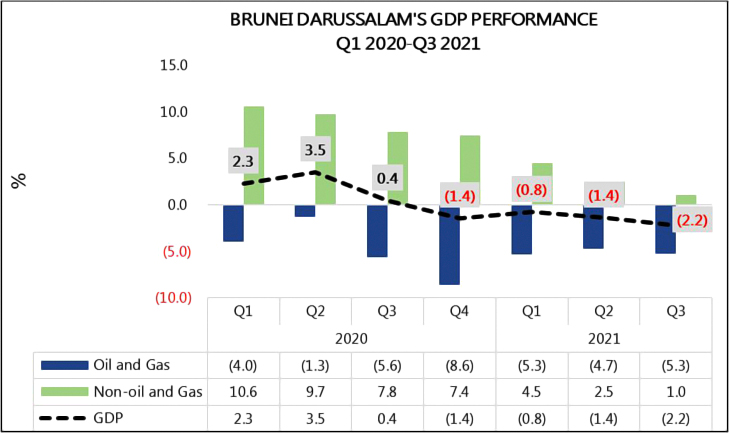In the third quarter (Q3) of 2021, Brunei Darussalam’s gross domestic product (GDP) growth rate declined by 2.2 per cent year-on-year. This was due to a decrease in the oil and gas sector by 5.3 per cent. The non-oil and gas sector, however, recorded an increase of one per cent.
The Sultanate’s GDP at current prices was valued at BND4.6 billion compared to BND4 billion in Q3 2020. The oil and gas sector, comprising of oil and gas mining and manufacture of liquefied natural gas (LNG), accounted for 47.4 per cent of the total gross value added (GVA).
Meanwhile, the non-oil and gas sector, which includes downstream activities such as the manufacture of petroleum and chemical products, contributed 52.6 per cent.
The decline in the oil and gas sector was due to a decrease in the production of crude oil from 100.6 thousand barrels per day in Q3 2020 to 97.1 thousand barrels per day in Q3 2021. Natural gas production also recorded a decrease from 30.7 million cubic metres per day in Q3 2020 to 28.5 million cubic metres per day in Q3 2021. In addition, LNG production declined from 834,489 MMBtu per day to 750,944 MMBtu per day during the same period of time. The reduction in crude oil and natural gas production was due to shutdown turnaround activities. In addition, the decrease was due to limited onsite workforce as a result of COVID-19 which reduced the ability to recover from unscheduled deferment and delayed of well, reservoir and facilities management (WRFM) activities. Meanwhile, the LNG production declined due to limited gas supply and maintenance activities at one of the LNG plant facilities.
Despite the country’s second wave of COVID-19, the non-oil and gas sector shows positive development. Among the subsectors that showed an improvement in Q3 2021 were finance, government services, communication, health services, and non-oil and gas manufacturing.
The increase in the finance subsector was in line with an increase in the income of financial and banking activities particularly the non-interest profit income.
This was followed by an increase in the communication subsector in line with the rise in domestic demand resulting from the reinstatement of control measures in preventing the spread of the second wave of COVID-19.
Meanwhile, the increase in the health services subsector was driven by an increase in the government health services activities. The non-oil and gas manufacturing subsector also registered an increase mainly supported by increased production of livestock feed.
In addition, the agriculture, forestry and fishery sector has continued to show encouraging performance since the second quarter (Q2) of 2020. In Q3 2021, this sector has increased by 27.9 per cent due to fishery, livestock and poultry, and agriculture production activities. An increase in the fishery subsector was in line with the rise in the capture industry particularly from small-scale fisherman activities. Meanwhile, farm prawns was the main contributor to the increase in aquaculture industry. An increase in the livestock and poultry subsector was due to increased production of buffalo meat and broilers while the increase in fruits and paddy production was the major contributor to the growth of the agriculture subsector.
By expenditure approach, a decline in GDP growth was mainly due to a decrease in the domestic demand by 11.5 per cent, which was driven by a decline in gross capital formation for both government and private, and government final consumption expenditure. However, this growth was moderated by an increase in the exports of goods and services by 44.5 per cent year-on-year, and the household final consumption expenditure by 13 per cent.
Gross domestic product is a measure of the total value of goods and services produced in a particular period after deducting the cost of goods and services used up in the process of production. The GDP full report for Q3 2021 is available from DEPS’s website: www.deps.gov.bn.









